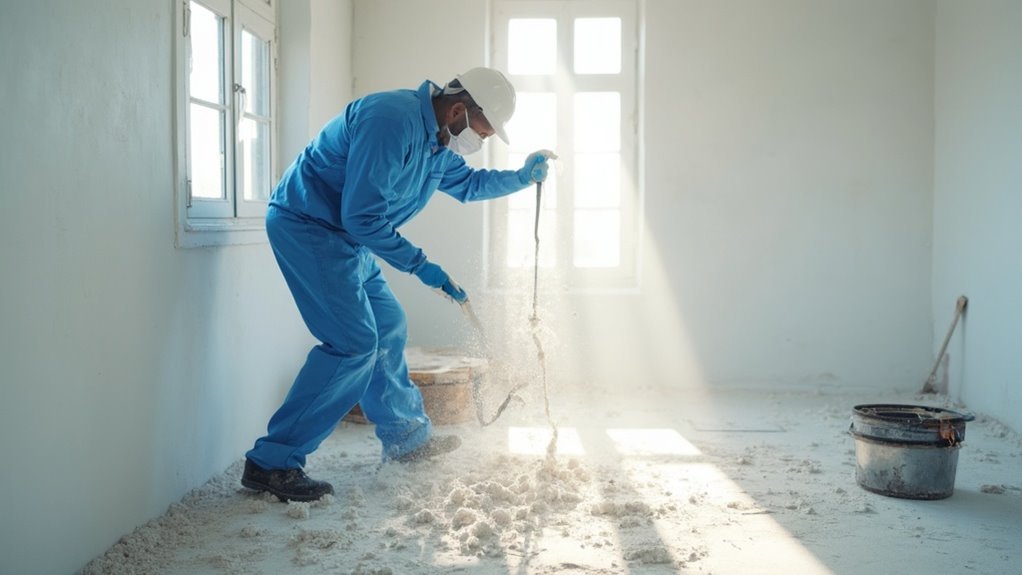Asbestos removal typically ranges from $1,192 to $3,255, making it more affordable than you might expect. Understanding the key factors—like size, accessibility, and local regulations—can help you plan your budget effectively. For instance, encapsulation can considerably lower costs to just $2 to $6 per square foot and reduce disruption. Hiring trained professionals guarantees proper handling and compliance, further safeguarding your investment. Plus, local regulations often necessitate testing, which adds transparency to pricing. With this knowledge, you'll see it's more manageable than it appears, and there's more to uncover about optimizing costs effectively.
Understanding Asbestos Removal Costs

When tackling asbestos removal, it's vital to grasp the costs involved, as they can vary widely based on several factors. Typically, you can expect average costs to range from $1,192 to $3,255, with a national average around $2,215. The pricing per square foot usually falls between $5 to $20 for interior locations, while exterior removal can run considerably higher. Notably, whole-home remediation can cost $5,700 or more, emphasizing the importance of assessing the scope of work needed.
Before any removal techniques are employed, asbestos testing is imperative for identifying the presence and extent of the hazardous material. This initial inspection can cost between $200 and $800, providing necessary insights that inform the overall budget. When it comes to specific areas, like attics or basements, costs can fluctuate based on accessibility and the complexity of the job. For example, attic removal may range from $15 to $25 per square foot, while finished basements often cost more. Effective removal methods require meticulous planning to ensure safety during the process.
Additional expenses might arise from disposal fees, which range from $300 to $800, and specialized equipment necessary for safe removal. Understanding these costs helps you budget effectively and guarantees you're prepared for a safe and efficient asbestos removal process.
Factors Affecting Pricing
Understanding the various factors that affect asbestos removal pricing is crucial for budgeting effectively. By grasping these elements, you can better anticipate costs and choose the right removal methods. Here's a pricing breakdown of what influences these expenses:
- Area and Size: Larger spaces increase costs greatly, with rates ranging from $5 to $20 per square foot.
- Accessibility: Hard-to-reach locations, like attics, may require more labor and specialized equipment, impacting overall pricing.
- Testing and Regulations: Asbestos testing can range from $250 to $850, and local regulations might necessitate permits that add $50 to $100 to your total.
- Local Costs: Labor and materials can vary widely based on your location, influencing the final price.
Additionally, it's important to consider that asbestos testing is not only a legal requirement but also a critical step in ensuring safety before any renovation begins.
Cost-Effective Alternatives

Exploring cost-effective alternatives to asbestos removal can save you significant money while still guaranteeing safety. One of the most prominent options is encapsulation methods, which involve sealing asbestos-containing materials with a protective coating. This approach typically costs between $2 to $6 per square foot, making it substantially cheaper than full removal, which can be double that price.
Encapsulation is less invasive, minimizing disruption to your daily life and reducing the environmental impact by limiting the amount of asbestos waste sent to landfills. It's particularly effective for non-friable materials, which are less likely to release harmful fibers when undisturbed. Properly choosing the encapsulant is vital; it must be compatible with the asbestos material to assure long-term effectiveness.
Regular inspections and maintenance are fundamental to guarantee the integrity of the encapsulation. This method not only addresses safety concerns but furthermore promotes environmental sustainability. By opting for encapsulation, you can effectively manage asbestos risks while saving money and reducing your carbon footprint. Understanding these cost-effective alternatives empowers you to make knowledgeable choices regarding asbestos management in your property.
Importance of Professional Help
Choosing cost-effective methods like encapsulation for asbestos management can be a practical approach, but it doesn't replace the need for professional help. Engaging trained contractors is vital for guaranteeing both safety and compliance. Their professional qualifications are significant in maneuvering the complexities of asbestos removal.
Consider the following benefits of hiring professionals:
- Trained Personnel: Skilled contractors undergo rigorous training in handling asbestos safely.
- Regulatory Compliance: They ascertain all necessary permits are obtained, adhering to laws and regulations.
- Safety Equipment: Professionals use specialized tools and protective gear, creating a safe work environment.
- Expert Assessment: They evaluate the scope of work, developing tailored strategies that improve project efficiency.
Safety and Compliance Considerations

Safety and compliance are vital pillars in the asbestos removal process, guaranteeing that both workers and the surrounding environment remain protected. To achieve this, you must adhere to strict safety protocols and compliance regulations. First, confirm that all workers are trained and accredited in asbestos handling. A written contract should specify the work plan, cleanup procedures, and applicable regulations, providing a clear framework for the project.
Before starting, verify state agency requirements and asbestos worker protection laws. When removing asbestos, avoid damaging the material and wet it down to minimize fiber release. Protective equipment is fundamental; workers must wear half-face filter respirators with appropriate filters and disposable coveralls to prevent contamination.
During the removal, use non-powered hand tools to limit dust generation and dispose of personal protective equipment properly. After completion, thoroughly clean the area using wet mops or HEPA vacuum cleaners, confirming it's free of dust and debris before allowing anyone back in. Following these safety and compliance considerations not only protects everyone involved but also contributes to a successful and efficient asbestos removal process.
Frequently Asked Questions
Can I Remove Asbestos Myself Without Professional Help?
You shouldn't attempt DIY asbestos removal without professional help. The risks of exposure are significant, and asbestos safety precautions require specialized equipment and training. It's safer and more compliant to hire certified professionals for removal tasks.
What Are the Long-Term Costs of Ignoring Asbestos Removal?
Ignoring asbestos removal can lead to significant long-term costs, including health risks from exposure and decreased property value. You may face increased healthcare expenses, legal liabilities, and diminished resale potential, impacting your financial stability.
Are There Government Grants for Asbestos Removal?
Yes, there are government grants for asbestos removal. You can investigate various funding options through EPA and HUD programs. Just guarantee compliance with asbestos regulations and provide necessary documentation to obtain financial assistance.
How Do I Choose a Licensed Asbestos Removalist?
When choosing a licensed asbestos removalist, note that 80% of contractors lack proper asbestos certifications. Verify their training in safe removal techniques, ensuring they meet industry standards to protect your health and property.
What Materials Can Safely Encapsulate Asbestos?
To safely encapsulate asbestos, you can use high-quality encapsulation materials like liquid sealants or non-asbestos spray coatings. These safe alternatives effectively bind fibers, ensuring compliance with EPA guidelines while minimizing health risks for occupants.
